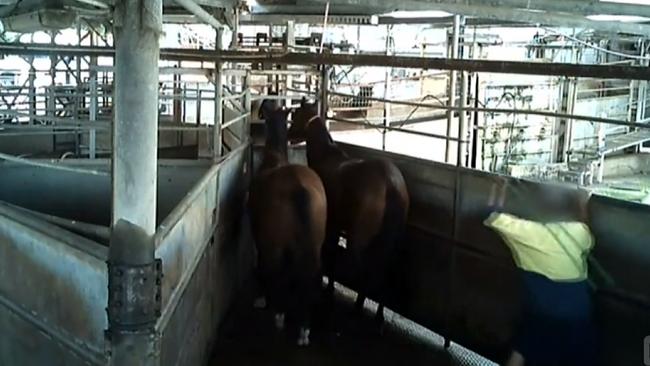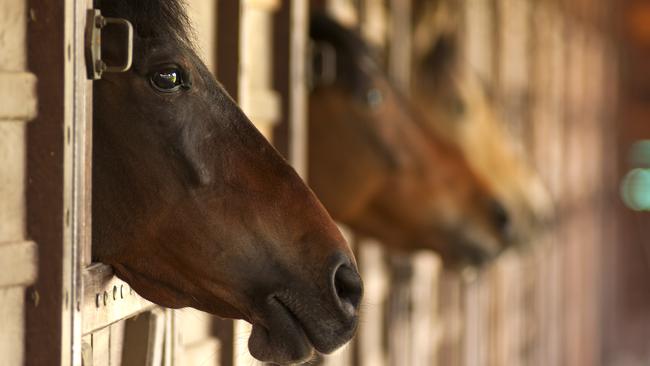Horse deaths: It’s a world of harsh facts
This week’s story on racehorse mass slaughter is an obvious reality that’s all about harsh mathematics, but there are ways to do it better, writes Andrew Rule.

Opinion
Don't miss out on the headlines from Opinion. Followed categories will be added to My News.
Don’t shoot the messenger. Shoot the horses.
If that sounds extreme, let me explain.
Shoot the horses … but quickly, cleanly and humanely in their own peaceful surrounds, so they are not trucked long distances, then maltreated before a terrifying death in an abattoir or knacker’s yard.
We refer, of course, to this week’s ABC TV current affairs story airing the open secret (and, frankly, obvious fact) that countless hundreds of racehorses are among thousands of horses slaughtered for meat in Australia every year.
It’s ugly viewing.
But what makes it extra tough for horse racing codes (apart from the gratuitous brutality, profanity and borderline sadism of carefully-filmed abattoir workers) is that racing’s brains trust should have seen this coming.
And having seen it coming, they should have done more than fluff up a public-relations campaign claiming that every retired racehorse would be “rehomed” and live happily ever after.
When greyhound racing was exposed in 2015, deservedly, for the use of live “lures” — rabbits, possums, poultry and piglets — to make dogs “chase”, it was only a matter of time before the same ABC team, informed by the same animal activist groups, would turn the lens on horse racing.
To do him justice, NSW racing supremo Peter V’landys smelt trouble and warned fellow “stakeholders” that horses would be next.
But the industry’s response was to cook up feel-good rehoming schemes that everyone pretended were a genuine fix.
The real world arithmetic is brutally simple.
Australia and New Zealand breed up to 20,000 thoroughbred foals a year; harness racing breeds several thousand standardbreds.
Many do not get to the track: through injury or unsoundness they go to horse sales and meat buyers.
Of those that do race, except for a relative few kept for breeding, most cannot be successfully rehomed.

The industry’s claims to the contrary ring hollow; no-one keeps track of what happens to a horse after the first supposed “rehoming”.
Fact: Several thousand horses quit racing every year and only a fraction of them go to proper permanent homes because only a fraction of them are suitable as hacks.
Fact: Old or barren mares retired from breeding are also destined for the sales from which no horse returns.
Fact: Most ex-racehorses are not suitable for anyone but the sort of experienced riders who, generally, breed or buy saddle horses unspoilt by racing.
For every off-the-track success story being shown or hacked or pony clubbed, dozens more are unwanted for good reasons.
V’landys and other rattled industry leaders made a rookie error by reaching for cuddly spin instead of facing reality and doing something constructive and practical.
They didn’t have the knowledge, or perhaps the courage, to admit that most racehorses are unsuitable for long-term rehoming.
To prevent the risk of neglect, cruelty (and danger to humans), surplus horses should be humanely euthanised under the strict supervision of the racing industry, preferably at a facility that can process the meat for export as carefully as if it is wagyu or spring lamb.
One story can illustrate a broader truth.
My late cousin, a soft-hearted trainer notorious for treating gallopers as gently as show horses, liked to place retired horses in good homes.
He sent a Traralgon Cup winner and a Gippsland Grand National winner to a high country cattle run.
Later, he trained a placid chestnut horse called Mount Price, who landed two betting plunges that paid off mortgages and motor cars.
When “Tommy” (Mount Price’s pet name) finished racing, my cousin gave him to a young woman near Pakenham amid assurances she would treat him like one of the family.
Much later, passing through, my cousin drove in to see “Tommy” — and was shocked to find him half-starved and worm-ridden.

He called a mobile knacker and insisted the driver put down the horse where he stood before taking away the carcass.
He never gave away another horse because he couldn’t be sure how or where it would end up. Instead, he paid for every horse to be put down at home, peacefully and with dignity.
Those who run racing should think about that.
The industry should levy owners to subsidise a state-of-the art abattoir in each state, policed by independent inspectors to ensure every unwanted horse is treated with respect until the end; any other “solution” is a Band-Aid.
That way, we won’t repeat the distressing scenes screened on Thursday.
Speaking of which, discerning viewers might think the story, high impact though it was, had some false premises and unanswered questions.
Such as, why is it worse for ex-racehorses to be processed for meat and fed to greyhounds, as opposed to any dog (or cat) eating any type of meat?
The honest answer is that it isn’t.
Ethically speaking, a french bulldog owned by a Northcote vegan being fed eye fillet is the same as a Dandenong greyhound eating horse meat or a Dubbo dingo eating kangaroo.
Such woolly thinking is not the only troubling thing.
It will be unfortunate if it turns out the ABC deliberately hid proof of ongoing cruelty for up to two years because it puts “winning” ahead of animal welfare.
Maybe we reporters can be as blinkered as the racing industry. And just as hypocritical.
Andrew Rule is a Herald Sun columnist.

